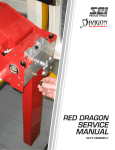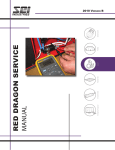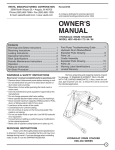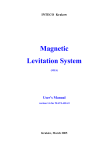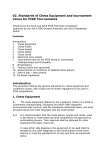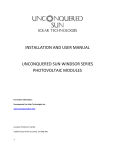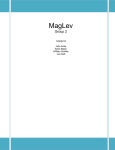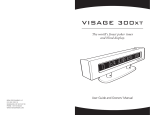Download Magnetic Levitation Track Construction Instruction Manual
Transcript
Magnetic Levitation Track Construction Instruction Manual August 2012 This document is intended to be used by Science Olympiad teams to assist them in building a magnetically-levitated track that will meet all specifications in the event rules for Magnetic Levitation and allow students to calibrate a maglev car in preparation for tournaments. This manual can also be used by Event Supervisors to construct a Magnetic Levitation track to be used at Science Olympiad tournaments. This document was created by Andy Hamm, National Maglev Event Supervisor in 2011 & 2012, and Science Olympiad Head Coach at Boyceville Middle/High School in Boyceville, WI. Any questions can be directed to him at [email protected] Track Specifications One of the main concerns with the Maglev event that has been expressed is the cost to purchase a track to allow students to build and calibrate Maglev vehicles. These tracks can cost anywhere from $85 to nearly $200. It was decided that a Maglev track could be created that is not only as consistent as a professionally-built track, but also less expensive. This Track Construction Instruction Manual will provide instructions on how to build two different styles of Maglev tracks...a cheap version and a more-expensive version. Please note the differences and be assured that very competitive vehicles can be created to run on either track. A more expensive track does not ensure a better vehicle score; rather, students are strongly encouraged to work with their vehicle(s) often to learn how to optimize their specific vehicle(s). The most expensive part of a Maglev track is the magnets, the 2013 rules allow a four foot (~1.22 m) track. The side rails of the track must be between 2.00 cm and 5.00 cm. The track width is encouraged to be 2 9/16” wide (65.1 mm), but this is not a requirement if you are bringing your own track to competition. Event supervisor-provided tracks must have a width of 2 9/16” (65.1 mm). Wood Maglev Track (Cheaper Version) 1. Supplies Needed to Build One Four Foot Long Track (Wood Version) 1 Steel Stud, 3 5/8 Inches Wide, 10 feet long (use shorter if available) 1 x 6 Piece of Wood (actually around 3/4 inches thick), at least 4 feet long 2 strips of wood, at least 4 feet long, between 2.00 cm and 5.00 cm tall, at least 3/4 inch wide 27 7/16” drywall screws, 1/2" long 4 small (around 5/8 inch) brass finishing nails or pins 1 north polarity magnetic strip 3/4 inches wide, around 1/8 inches tall, 4 feet long 1 south polarity magnetic strip 3/4 inches wide, around 1/8 inches tall, 4 feet long OR instead of magnetic strips around 120 ceramic rectangular magnets 1” x 3/4" x 3/16” Tools Needed for Construction: Hack Saw or Chop Saw, Planer, Phillips Screw Driver, Hammer, Drill, Wood Glue, Ruler/Measuring Tape, Caliper Page 1 Magnetic Levitation Track Construction Instruction Manual August 2012 2. Track Base & Side Rail Construction Construction of the track begins with a steel stud, 3 5/8 inches wide, 10 feet long (use shorter if available). These are available at most hardware/home improvement stores, and examples include: Marino Ware 10 ft. Steel Track (Model # 358VT2510H) Home Depot - $5.91 Steel Stud 3 5/8” Wide 10 ft. Long Pro Build - $3.89 These steel studs offer inexpensive, sturdy foundations on which to begin building the track, and wooden side rails can be attached to the sides of the steel stud easily. Since a four foot track is desired, the first step is to cut the ten foot long steel stud into three segments, providing two four foot segments and the remaining segment is scrap. Next, it is important to mount the stud to a wood base to increase stability. One of the easiest and least-expensive ways to do this is to purchase a 1 x 6 board of wood or obtain one from your school’s Technology Education Department. Keep in mind that this wood is actually around 3/4” thick. Cut this board to four feet in length and this will be mounted beneath the steel stud. Page 2 Magnetic Levitation Track Construction Instruction Manual Note the steel stud on top of the 1 x 6 wood, in this case pine. August 2012 The steel stud is connected to the 1 x 6 wood underneath it with screws in the middle of the stud. Be sure to keep the screws in the middle to not be in the way of the magnets to be added later! Use nine screws spaced around 7.5 cm apart. The screws used throughout the construction were 7/16 inch drywall screws, phillips head, 1/2 inch long. Now, it is time to construct the wooden side rails to ensure the track is the correct width, as this is the most important part of the construction. It is of the utmost importance to get the width of the track as close to the required width as possible to ensure that your students’ cars and calibrations will be correct on tournament day (if your students are using the event supervisor-provided track). The side rails can either be constructed out of one piece of wood or two, depending on what you have available. Either can be used to construct a precise track. If you are bringing your track to competition, be advised that the track width need only be between 2” and 3”. You are still recommended to be near 2 9/16” wide, but there is no need to plane the wood side rails down to a specific size. If you are building a track to a width of 2 9/16”…since the width of the steel stud is 3 5/8 inches and the track width for a Maglev track is 2 9/16 inches, and side rails will be added to both sides of the track, you will generally want wood that is 17/32 inches wide, or approximately 0.531 inches wide. However, it is important to note that steel studs can vary slightly and you should measure the interior width of your steel stud throughout the track and make any adjustments that are necessary. This is why the addition of the wood side rails is so important as this allows you to adjust the construction of the track to ensure the proper width. Page 3 Magnetic Levitation Track Construction Instruction Manual August 2012 Unfortunately, many hardware and home improvement stores do not sell wood that is cut to exactly the correct width and height (remember, the side rail height restrictions are between 2.00 cm and 5.00 cm above the level of the magnets). This is where your district’s Technology Education department can help. A device called a planar can be used to very precisely trim the thickness of a piece of wood. By purchasing (or finding in your Technology Education department) two strips of wood at least four feet long and between 2.00 and 5.00 cm high, you can plane this wood to the correct thickness for your track and cut the wood to the correct height to ensure that the side rails fit within the required dimensions. If you can’t find any wood that is tall enough for the side rails, but they are close to the correct thickness and length and can be planed to the correct thickness, you can glue two pieces of wood together using wood glue and clamping the wood overnight. You can also add screws to the top of the side rails for added strength as long as your side rails to not extend above the 5.00 cm height restrictions. Finally, it is easiest to simply screw the wooden side rails to the sides of the steel stud, with the heads of the screws on the outside of the track. Note the screws connecting the wood side rails to the steel stud, which is also screwed into the 1 x 6 board underneath. There are a total of nine screws used for connection, one on each end and the other seven equally spaced along the track (around 7.5 cm of separation for each screw). Make sure that the ends of the screws do not protrude into the track as you want a very smooth side wall to minimize frictional drag on the Maglev cars. Make sure that the width of your track is consistent for the entire length. This is easily checked with a digital caliper. You can adjust your wood side rails as needed (as they are easily removable) to ensure that the track width remains consistent throughout the entire five foot long track. It is strongly encouraged to sand the inner walls of the wooden track to reduce frictional interactions between the track and the maglev vehicles. Page 4 Magnetic Levitation Track Construction Instruction Manual August 2012 3. Magnetic Tracks The last part of the Maglev track is the magnetic tracks on both sides of the bottom of the track. There are two ways that this can be constructed. 1) Ceramic square magnets (with circular holes in their middle section) can be physically screwed into the base of the steel stud and then into the 1 x 6 board using small screws, with as small of heads as possible to prevent frictional losses or drag on the Maglev cars. These ceramic magnets are available at many hobby stores or online and can also be used on the Maglev cars and sled. One such store that offers these ceramic magnets is Kelvin out of New York (www.kelvin.com). These ceramic magnets are available in packages of 250 for $32.50. You will need around 120 magnets for the track (60 for each side), leaving you with plenty of magnets to either build a second track with you left over steel stud or many cars and sleds for your students to use to practice. 2) Magnetic tape can be used with no loss in magnetic strength. However, it is important that the magnetic tape be north/south polarity-based tape and not general magnetic tape. An example of polarity-based magnetic tape is offered by Kelvin out of New York (Item: 640102). Ceramic rectangular magnets as sold by hobby stores and Kelvin. Standard dimensions are 1.0 inch long x 3/4 inches wide x 3/16 inches thick. To change the polarity, simply flip the magnet upside down. Magnetic tape (polarity-based) as sold by Kelvin. Two 10 foot segments are available for $34.95, though only 4 feet of each type is needed, leaving you with plenty of tape to either build a second track or for your students to use to build Maglev cars and sleds. Keep in mind that you will receive 2 segments in the mail…one is the north, one is the south. If the magnetic tape is used, one side is usually sticky, which allows it to stick to the track better. In addition, since a steel stud was used, the magnetic strips are going to tend to want to stay in place due to the magnetic attraction to the steel stud underneath the strip. It is also recommended to nail the ends of the magnetic strip down into the steel stud and 1 x 6 board underneath using small brass nails or pins around 5/8 inches long, which are available at most local hardware stores. Finishing nails with very small heads work best for this. Page 5 Magnetic Levitation Track Construction Instruction Manual August 2012 Note the small brass pin that is nailed into the end of the magnetic strip, through the steel stud and into the 1 x 6 board underneath the steel stud. This ensures that the end of the magnetic strip does not become detached from the steel stud and warp upwards over time. You now have a completed Magnetic Levitation track! Below is a picture of a track that I created and used at the 2012 Wright State University Invitational as a demonstration during the Magnetic Levitation Trial Event. Results on this track were very similar to the results students had with their cars on the much more expensive professionally-built track. Page 6 Magnetic Levitation Track Construction Instruction Manual August 2012 4. Total Cost for Wood Maglev Track As described earlier, one of the major concerns with this event is the high cost. Below is a description of the cost of the two tracks (five feet long) I was able to create for Boyceville MS & HS (Boyceville, WI) to practice with during the 2011-2012 competitive season. A four foot track will be slightly cheaper than listed below: 1 Steel Stud to Above Dimensions (for 2 tracks) 2 1 x 6 Blocks of Pine to Above Dimensions 4 Strips of Wood for Side Walls to Above Dimensions 54 7/16” drywall screws, 1/2" long (Box of 100 Purchased) 8 small (around 5/8 inch) brass finishing nails or pins (Box of 100) 1 KELVIN Polarity Magnetic Strip Bundle (10 feet long for 2 tracks) $3.89 (Pro Build) $3.76 (Pro Build) $4.62 (Pro Build) $3.99 (Fleet Farm) $4.99 (Fastenal) $34.95 (Kelvin) Total: $56.20 for 2 Tracks Total: $28.10 Per Track Aluminum Maglev Track (More Expensive, More Adjustable Version) 1. Supplies Needed to Build One Four Foot Long Track (Aluminum Version) . 1 x 6 piece of wood (actually around 3/4 inches thick), at least 4 feet long 4 small (around 5/8 inch) brass finishing nails or pins 2 aluminum angle segments, four feet long, up to 2” x 2” x 1/8” 1 aluminum flat bar, four feet long, 1” wide (OPTIONAL) 21 7/16” screws, 1’2” long 1 north polarity magnetic strip 3/4 inches wide, around 1/8 inches tall, 4 feet long 1 south polarity magnetic strip 3/4 inches wide, around 1/8 inches tall, 4 feet long OR instead of magnetic strips around 120 ceramic rectangular magnets 1” x 3/4" x 3/16” Tools Needed for Construction: Ruler/Measuring Tape, Caliper Hack Saw or Chop Saw, Phillips Screw Driver, Hammer, Drill, 2. Side Rail Track Construction The aluminum side rail Maglev track begins with the 1 x 6 piece of wood, cut to a four-foot length. The two aluminum angle segments will make the side rails, with the “L” pointing away from the track (see images below). Page 7 Magnetic Levitation Track Construction Instruction Manual TOP: A Side View of the Aluminum Side Rail Maglev track. Note the 1 x 6 piece of wood on the bottom and the location for the aluminum angle. BOTTOM: Top View of Track August 2012 A Top View of the Aluminum Side Rail Maglev track. This diagram shows the ceramic magnets used; however, north/south polarized magnetic tape could also be used. Make sure that the magnetic tape comes in two rolls and each roll (north vs. south polarity) is placed on an opposite side of the track. The aluminum angle segments can be screwed into the 1 x 6 base using the 7/16” screws. For a four feet segment seven screws should be sufficient. Affix one screw near each end of the aluminum angle and separate the other five screws evenly across the segment (about 9 inches separating each screw). Make sure that the track width is as close to 2 9/16” as possible, especially if you are an Event Supervisor. OPTIONAL…Next, you can attach the 1” segment of flat aluminum to the bottom of the track, immediately in the middle of the track. You can again use 7/16” screws, but you want the heads of the screws to be as small as possible to prevent contact with the vehicles on the track. Again, seven screws should be sufficient to attach the flat aluminum bar to the 1 x 6 base, each separated by about 9 inches. If you do not add the aluminum flat, make sure your magnets are aligned and placed properly! 3. Magnetic Tracks Please read the above section 3 on Magnetic Tracks to learn how to set this up in your aluminum side rail Maglev track. Page 8 Magnetic Levitation Track Construction Instruction Manual August 2012 4. Total Cost for Aluminum Side Rail Maglev Track As described earlier, the aluminum side rails will cause this track to be more expensive than the Wood Maglev track listed above. Below is a description of the cost of two tracks (four feet long): 2 1 x 6 Blocks of Pine to Above Dimensions 21 7/16” screws, 1/2" long (Box of 100 Purchased) 4 1.5” x 1.5” x 1/8” Aluminum Angle, 4 Feet Long 2 1” x 1/8” Aluminum Flat Bar, 4 Feet Long 8 small (around 5/8 inch) brass finishing nails or pins (Box of 100) 1 KELVIN Polarity Magnetic Strip Bundle (10 feet long for 2 tracks) $3.76 (Pro Build) $3.99 (Fleet Farm) $26.48 (OnlineMetals.com) $5.04 (OnlineMetals.com) $4.99 (Fastenal) $34.95 (Kelvin) Total: $79.21 for 2 Tracks Total: $39.61 Per Track (Not including Shipping & Handling) Page 9










